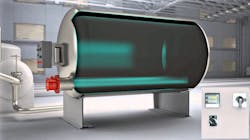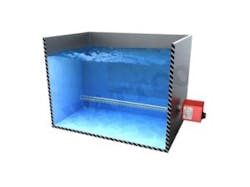Immersion Heaters for Water Purification
Sanitize Distribution Loop
Any water purification system requires periodic sanitation as part of regular maintenance. Immersion heaters are used to raise the temperature of water flushed into the distribution loop and storage tank to kill bacteria.
Sanitation can be achieved with ozone or chemicals, but heat sanitizing with water is the ideal option. Raising the temperature to 80°+C (176°+F) is sufficient for sanitation without having to worry about chemical handling and rinsing. As a result, flushing the system with hot water is both safer and faster.
Sanitize Carbon Tanks
In water purification for consumption, activated carbon tanks are commonly used to remove chlorine, organics, and anything else that can affect the taste or smell of the water. To keep these tanks safe from bacteria and prevent them from adding their own flavors and odors, it’s important to keep them sanitized.
As with the distribution loop, an immersion heater can be used to heat water for the sanitation of active carbon tanks.
Preheat Water for Processes
Water purification that requires chemical processes, such as clean-in-place processes, is more effective with an immersion heater. The water purification heater heats the chemical mixture, making the process more efficient.
Thermal Pasteurization
Thermal pasteurization is a process that can be used to kill pathogens and/or extend the shelf life of a product. For instance, thermal pasteurization is frequently used to prevent Legionnaires’ disease, which is caused by legionella bacteria. The treatment eliminates the bacteria, removing the risk.
Liquid products can be treated with water and steam heated by an immersion heater.
Water Purification Heater Types
Water purification heaters typically use either flanged heaters or screw plug heaters. Both offer direct heating, providing rapid, even heating, with precision temperature control. The best heater type depends on the specifics of the application.
Flange Heaters
Electric flanged heaters are a diverse and efficient tool. With custom element configurations they can be used in almost any tank size. The custom elements allow for even heating regardless of the shape or size of the vessel.
They are commonly used in water-based applications, although the available sheath materials make flanged heaters ideal, even when heating corrosive solutions. The typical configuration is an ANSI-rated flange with multiple hairpin elements or bugle tubular elements.
Screw Plug Heaters
Screw plug heaters offer a similar operation to flange heaters, but their installation differs. They are screwed directly into a tank, making them the most efficient option for heating a tank. Unlike flanged heaters, however, they are not suitable for larger tanks.
In small vessels, screw plug heaters are the ideal option. Medium and large tanks, however, should consider flanged heaters for water purification.
WATTCO custom-manufactures electric heaters for water purification. The designs are customizable to match the specifications of your operation, tanks, distribution loops. Our team will help you choose the optimal material selections, element configurations, and wattages for your operational needs.


